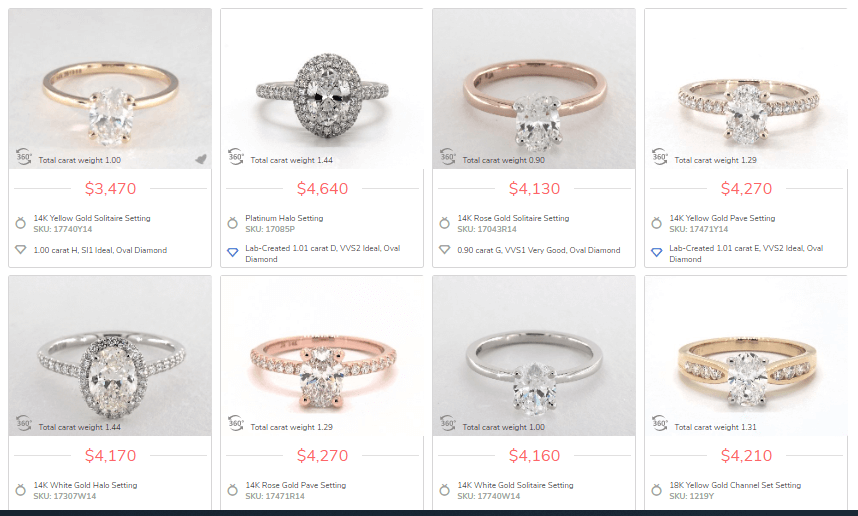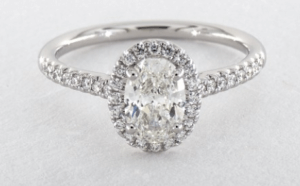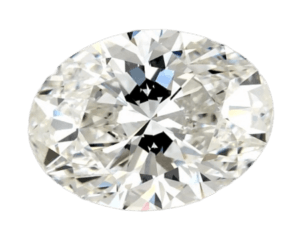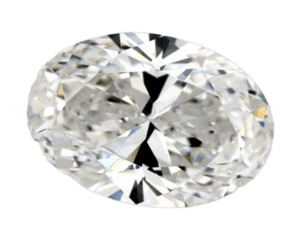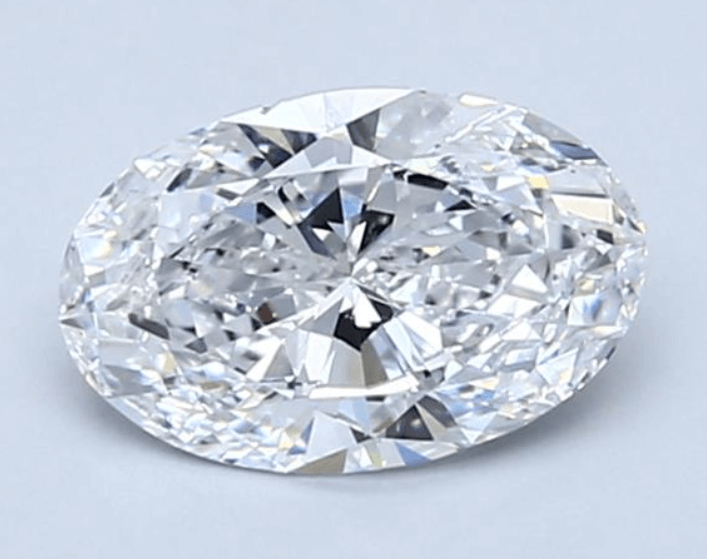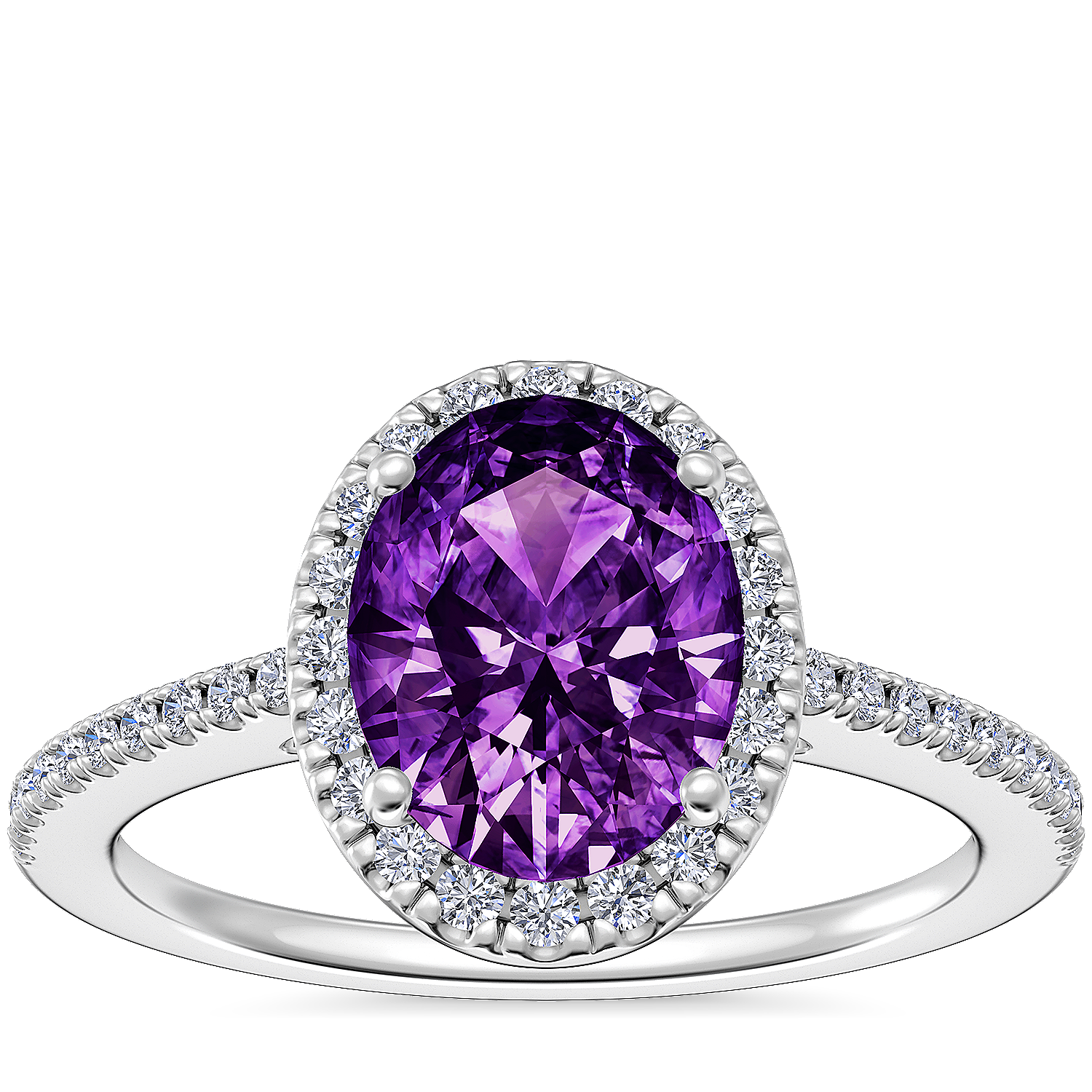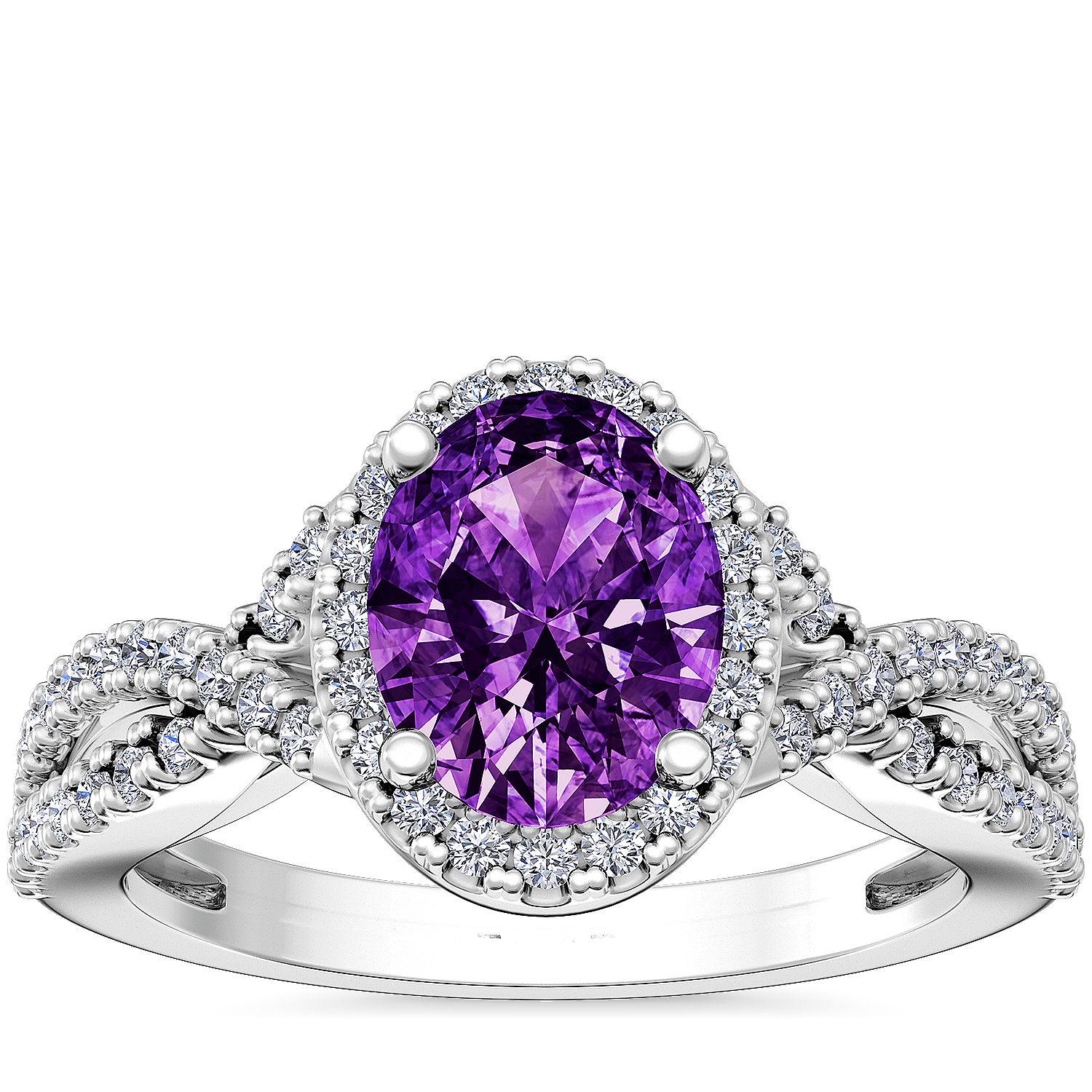Oval Diamond Buying Guide
Oval Diamond Buying Guide: Unlocking the Brilliance
Ah, oval diamonds. If you’re in the market for a show-stopping gem that exudes elegance and sophistication, then the oval diamond is a top contender. That’s where our comprehensive oval diamond buying guide comes in. Whether you’re a first-time buyer or a seasoned diamond collector, this guide will help you unlock the brilliance of oval diamonds and make an informed purchase.
In this guide, we’ll cover everything you need to know, from the 4Cs (cut, color, clarity, and carat weight) to the importance of symmetry and proportion. We’ll also delve into the different settings that pair beautifully with oval diamonds, helping you create a truly customized piece that reflects your style and personality. So, get ready to embark on a sparkling journey and discover the secrets to selecting the perfect oval diamond. Let’s unlock the brilliance together!
With that in mind, here is a guide on how to buy an oval diamond correctly so it can be as beautiful as this ring! Oval diamonds are beautiful, unique shapes that can provide excellent value for money – but only if you know how to buy them correctly. In this blog post, we’ll guide you through the process of understanding oval diamonds, so that you can make a purchase with confidence. Let’s get started!
Oval-Cut Diamonds give a beautiful sparkle and style
It’s recommended you choose an H color to be on the safe side and Si1 clarity. Occasionally you can find an SI2 that looks great but it’s not too common. The length-to-width ratio is equally important to ensure you have a classic oval shape.
One must evaluate an Oval diamond closely as it’s not as simple as a round. GIA doesn’t classify cut grades for any shape other than round. You will have to analyze the stone with other criteria.
Take a look and click on this link to view an oval diamond that has the same 4 C’s but has a drastic difference in cut and look. Stone A vs Stone B You can see the shape and clarity affect this diamond’s brilliance.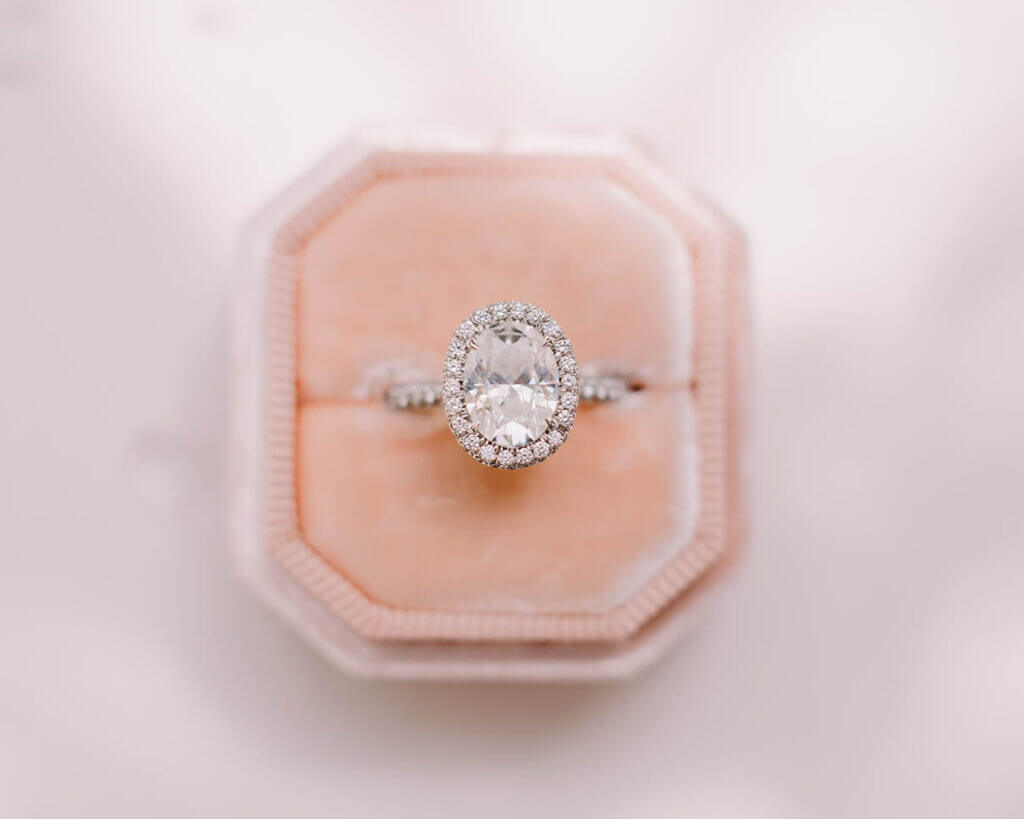
The brilliance of oval diamonds and why are they so popular right now?
Oval diamonds are a popular choice for those seeking a unique and eye-catching gem. Their elongated shape, combined with their brilliant faceting, creates a mesmerizing sparkle that is hard to resist. The oval cut is also known for its ability to create the illusion of longer and slimmer fingers when worn as a ring.
Oval-shaped diamonds have the unique ability to elongate the size of the center stone because they possess 58 facets, at least 12 more than a traditional round diamond giving you maximum bling with minimum effort. The oval cut is actually considered quite a romantic choice too – its stunning edges can catch your eye from across the room, just like it caught your heart in the first place! Celebrities such as 1 · Kourtney Kardashian ; 2 · Ariana Grande ; 3 · Blake Lively ; 4 · Hailey Bieber all are rocking the ovals!
Oval diamonds can range in length-to-width ratio, allowing you to choose a shape that best suits your preferences. Whether you prefer a more elongated oval or a slightly rounder shape, there is an oval diamond out there for everyone. In the cut selection below, you will learn the appropriate dimensions that give you the ideal light return.
Factors to consider when buying an oval diamond
When purchasing an oval diamond, several critical factors should be carefully considered to ensure you make a well-informed decision. Firstly, the aspect ratio, which is the length-to-width ratio, plays a pivotal role in the diamond’s overall appearance. A classic oval shape typically has a ratio between 1.3 and 1.5. Click here to see an example of a beautiful Oval with an Ideal L/W ratio. The quality of the cut is crucial, as it affects the diamond’s brilliance and symmetry – a well-cut oval diamond should display even light distribution and minimal bow-tie effect. Which is a dark area resembling a bow tie that can appear in the center of some oval diamonds. Clarity and color are also important. I consider an SI1 grade ideal if you can find an eye-clean stone. No need to pay extra for the quality a microscope can see. Here is an Ideal SI1 example. With a preference for a stone that balances these qualities with your budget, keeping in mind that certain inclusions can be more noticeable in an oval cut. Additionally, the setting should complement and protect the diamond, as oval stones can have more exposed edges compared to round cuts. Finally, it’s advisable to check the diamond’s certification from reputable labs like GIA or AGS to verify its quality and ensure a sound investment.
Whats the best Length To Width Ratio in oval diamonds?
Oval diamonds are considered ideal in the 1.35- 1.50 length-to-width ratio. Most sites do the calculation for you but it’s achieved by dividing the length of the diamond with the width. Click here to see an example of a beautiful Oval with an Ideal L/W ratio. Click here to see a short, not ideal Lenght to width ratio. View the photo sample below for a detailed breakdown of its l/w ratio.
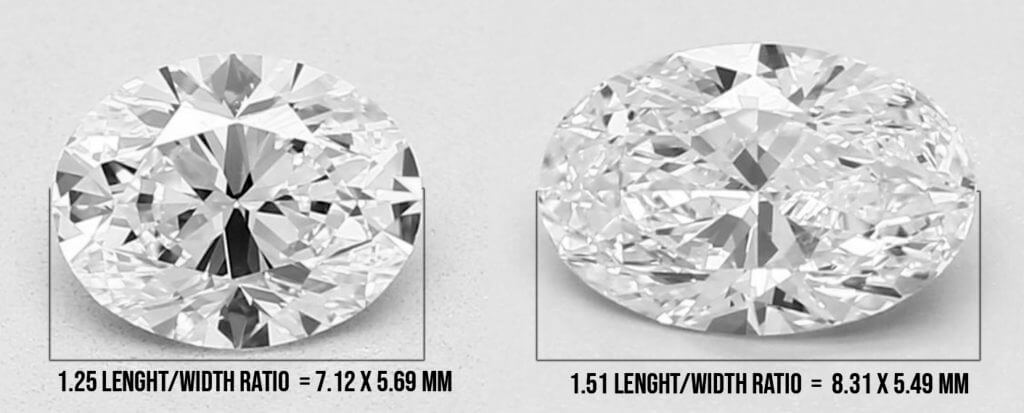
As you can see, even though the carat weight is the same, you gain over 1 millimeter in size by having an ideal L/W ratio. As an example, you would have to increase your carat size by over .60 to gain another 1 millimeter. Don’t go to far above the 1.50 ratio or you will have a skinny-looking stone that will affect the brilliance. Also, avoid stones under the 1.35 L/W ratio, it will look stubby.
This comes down to personal preference if one prefers a rounder or longer look. Here is a link to show you examples of finished rings. Use this to compare what a rounder or longer Oval Diamond looks like mounted.
OVAL DIAMOND INSPIRATION EXAMPLES
OVAL DIAMOND BUYING GUIDE: 5 TIPS VIDEO
FOR THOSE THAT LIKE TO LISTEN, HERE IS A QUICK VIDEO I CEATED ON THE TOPIC
Understanding the 4Cs of oval diamonds
When selecting an oval diamond, the shape and size are highly personal choices that should align with your preferences and style. Oval diamonds come in various length-to-width ratios, ranging from a more elongated shape to a rounder appearance.
The length-to-width ratio determines the overall shape of the oval diamond. A ratio of 1.35-1.50 creates a more elongated oval, while a ratio closer to 1.00 will result in a rounder shape.
Shopping for an oval diamond can feel like deciphering a foreign language. But you don’t need to be a gemologist to get the best oval diamond for your buck – just understand the four C’s: color, clarity, carat weight and cut. Color ranges from D (colorless) to Z (light yellow). Clarity describes how clear the diamond is and is graded on a scale ranging from Flawless to Included. Carat weight is simply how big the oval diamond is – bigger is obviously better! Finally, cut refers to how well each facet of the oval diamond reflects light back out at you. Once you have mastered these basics, you’ll be able to find that perfect oval diamond every time!
What is the Best Diamond Color For Oval diamonds?
The color scale by GIA starts at the letter D to Z. D represents colorless and Z means there is a very noticeable brown and yellow color. Color originates from the bottom tip of the diamond typically making it harder from the top view to see color.
It’s very difficult to see the difference between 2 neighboring color grades and generally recommend to stick to H color or better for Oval Diamonds. This is a perfect balance between quality and price and ensures that you have a diamond that radiates white. If you set your diamond in yellow or rose gold feel free to lower your diamond color to a J or K color to save money or increase carat size.
As an example, look at this J color diamond on a yellow gold ring.
What is the best Oval Diamond Clarity Grade?
There are many grades given to diamonds. Below is a chart outlines them

Most diamonds sold fall under the I1 grade and vvs1. I consider this the least important C. A diamond that is flawless and a diamond that’s an eye clean SI1 is indistinguishable to the human eye. SO WHY pay such a high premium for a flawless.
Here is an example of an incredible SI1 that is almost perfectly clean magnified online and will be eye-clean to the human eye. IS it easy for you to see a flaw?
Is it worth spending an additional $2,500 by buying This VVS1 diamond? I try my hardest to have my clients avoid overspending and using that money to upgrade carat size, color, or engagement ring. That’s money better spent where your eye can actually see a difference.
What is the best cut grade for oval diamonds?
As I have stated in previous articles, the “Cut” is king and there is no exception here. Oval diamond presents a problem because GIA does not give it a cut grade. Due to the oval shape complicated structure, there is no ideal standard. Too many variables are at play between various length, width and depth combinations, so getting an ideal table and crown angle is difficult.
With that said, there is no ideal combinations so you must take this advice as a general rule of thumb. Below are guidelines to follow that lead you in the right direction.
Ideal Oval Cut Buying Guidlines
I have created a prefiltered settings list of stones with ideal settings for you. One click and you will see a list of top diamond cuts. CLICK BUTTON FOR PRE-SELECTED CRITERIA
| OVAL | EXCELLENT | VERY GOOD | See Ideal Sample |
|---|---|---|---|
| Table % | 53-63 | 52 or 64-65 | SAMPLE1 |
| Depth % | 58-62 | 56-58 or 62-66 | SAMPLE2 |
| Girdle | Very Thin - Slightly Thick | Very Thin - Slightly Thick | SAMPLE3 |
| None | Very Small | Very Small | SAMPLE4 |
| Lenght To Width Ratio | 1.35-1.50 | 1.30-1.35 or 1.50-1.55 | SAMPLE5 |
Understanding the BOWTIE EFFECT FOR OVAL DIAMONDS
A big tip in this Oval Diamond Buying Guide is understanding the bowtie effect. All Ovals will have it with degrees of variance. With a strong bowtie, You will see a dark effect sketching from the top to the bottom middle. It can be very visible or barely noticeable. You want to avoid the strong effect as it will affect the brilliance of the diamond. Feel free to reach out to me if you need any advice with a selection of yours.
Below you will see a photo example of a bad and great bowtie.
Click on the buttons to show diamond bowtie examples
What are the best engagement rings for oval diamonds?
ENGAGEMENT RING CHOICES ARE SUBJECTIVE AND OVALS GO WELL WITH ANY STYLE BUT HERE ARE A FEW POPULAR CHOICES FOR OVAL ENGAGEMENT RINGS.
- Classic Solitaire: A classic solitaire setting is a timeless and simple setting that allows the oval diamond to take center stage. This setting typically features a single oval diamond in the center with a plain metal band. This setting is perfect for those who want a classic and elegant look.
- Halo Setting: A halo setting features small round diamonds surrounding the center oval diamond. This setting adds extra sparkle and can make the oval diamond appear larger. It’s a great option for those who want a bit more bling in their engagement ring.
- Three-stone Setting: A three-stone setting features three diamonds, usually with the center diamond being an oval diamond. This setting is perfect for those who want to symbolize the past, present, and future of their relationship. It’s also a great option for those who want a more unique and symbolic engagement ring.
- Vintage-inspired Setting: A vintage-inspired setting can add a touch of elegance and nostalgia to an oval diamond engagement ring. This setting can feature intricate details such as milgrain edging and filigree work, adding a unique and vintage touch to the ring.
- Split-shank Setting: A split-shank setting features a band that splits in two, with the center oval diamond sitting on top of the split. This setting is perfect for those who want a more contemporary and unique look. The split shank also helps to elongate the fingers and accentuates the oval shape of the diamond.
OVAL DIAMOND INSPIRATION EXAMPLES
It’s important to consider the style and design that you and your partner prefer and also the metal that the ring will be made of. A good idea is to have a look at the different settings with a loose diamond to see what looks best on your finger and what complements the diamond. Ultimately, the best engagement ring for an oval diamond is one that you and your partner love and will cherish for years to come.
Oval Diamond Carat Sizes
Here are varies of oval diamonds based on MM measurements.
| Oval MM Size | Oval Carat Weight |
|---|---|
| 3.6×2.7 mm. | 0.10 ct. |
| 4×3 mm. | 0.15 ct. |
| 4.5×3.5 mm. | 0.20 ct. |
| 5×3.5 mm. | 0.25 ct. |
| 5.5×3.5 mm. | 0.33 ct. |
| 5×4 mm. | 0.35 ct. |
| 6×4 mm. | 0.50 ct. |
| 6×5 mm. | 0.61 ct. |
| 6.5×4.5 mm. | 0.65 ct. |
| 7×5 mm. | 0.75 ct. |
| 7.7×5.7 mm. | 1.00 ct. |
| 8×6 mm. | 1.25 ct. |
| 9×6 mm. | 1.41 ct. |
| 8.5×6.5 mm. | 1.50 ct. |
| Oval MM Size | Oval Carat Weight |
|---|---|
| 9×7 mm. | 2.00 ct. |
| 10×8 mm. | 2.50 ct. |
| 10.5×8.5 mm. | 2.88 ct. |
| 12×8 mm. | 3.00 ct. |
| 11×9 mm. | 3.85 ct. |
| 12×10 mm. | 5.05 ct. |
| 14×10 mm. | 5.81 ct. |
| 13×11 mm. | 6.05 ct. |
| 14×12 mm. | 8.21 ct. |
| 15×12 mm. | 8.76 ct. |
| 16×12 mm. | 9.32 ct. |
| 16×14 mm. | 11.88 ct. |
| 18×13 mm. | 12.86 ct. |
| 20×15 mm. | 14.96 ct. |
Conclusion: Finding your perfect oval diamond
In conclusion, both oval and round diamonds have their own unique characteristics that make them desirable. Oval diamonds are known for their unique and timeless look and can appear larger than round diamonds of the same weight. Round diamonds, on the other hand, are known for their classic and timeless look and are known for their sparkle and fire. Ultimately, the choice between an oval and a round diamond comes down to personal preference and what you feel looks the best.

